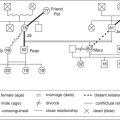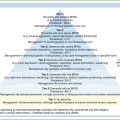Chapter 23 THE OLDER PERSON WITH ANXIETY
INTRODUCTION
Anxiety is a universal and normal human experience. It has survival value when it leads an individual to avoid danger. Anxiety is an important component of the mammalian ‘fight or flight’ response and one manifestation of sympathetic nervous system arousal. A certain degree of anxiety is often associated with increased performance, but excessive anxiety is associated with reduced performance. Anxiety accompanies most general medical conditions such as heart attacks and strokes. It also accompanies most mental health problems such as depression, dementia and schizophrenia. However, anxiety can be the main feature of several anxiety disorders that are not necessarily associated with a general medical condition or another mental health problem. This chapter is about these so-called primary anxiety disorders. Key issues include the diverse presentation of anxiety disorders and the selection of appropriate treatment approaches for older people.
EPIDEMIOLOGY
Anxiety disorders are the commonest mental disorders in older people after dementia. The 1997 National Survey of Mental Health and Wellbeing (NSMHW) (Australian Bureau of Statistics 1998) found that 3.5% of males and 5.4% of females aged 65 years and over were suffering from an anxiety disorder. This survey was limited to community-residing individuals without significant cognitive impairment and thus was likely to have underestimated the true prevalence of anxiety disorders in older people. However, the survey found that the prevalence of anxiety disorders declined with age. Table 23.1 shows the prevalence of specific anxiety disorders among people aged 65 years and over from the same survey.
Table 23.1 Prevalence of anxiety disorders in older people
| Disorder | Prevalence |
|---|---|
| Generalised anxiety disorder | 2.5% |
| Panic disorder | 0.6% |
| Panic disorder with agoraphobia | 0.3% |
| Agoraphobia without a history of panic attacks | 0.1% |
| Post-traumatic stress disorder | 1.1% |
| Social phobia | 0.5% |
| Obsessive-compulsive disorder | 0.1% |
CLINICAL FEATURES
Generalised anxiety disorder (GAD) is characterised by longstanding pathological anxiety. As currently defined by DSM–IV (American Psychiatric Association 2000), this anxiety must persist for at least 6 months for the diagnosis to be made. The person with GAD commonly worries or ruminates about many different things and experiences these worries as uncontrollable. Older people seem particularly prone to worry about their health and finances, or about the circumstances of their children or grandchildren. The topics of worry are often in the indeterminate future and not under the control of the person. Sometimes, the person with GAD also has free-floating anxiety (i.e. anxiety without a clear subject or focus). They usually feel nervous and unable to relax. They often feel irritable and restless and report difficulty concentrating. They are hypervigilant and startle easily. They often report increased muscle tone or tension and associated aches and pains. Not infrequently they have a fine tremor and psychomotor agitation. They commonly report marked sleep disturbance, with initial, middle and terminal insomnia and unrefreshing sleep. They often feel fatigued.
Clearly, these symptoms overlap to a considerable degree with the symptoms of major depression and may occur in many other psychiatric disorders. GAD also needs to be distinguished from what might be termed normal worry and from a variety of other conditions. These include hyperthyroidism, excessive caffeine consumption, the use of stimulants such as pseudoephedrine and amphetamine, and alcohol or benzodiazepine withdrawal.
Panic attacks are discrete episodes of marked anxiety that typically last no more than 10 minutes. Classical panic attacks, as described in DSM–IV (American Psychiatric Association 2000), are much more commonly experienced by young and middle-aged people, but do occasionally occur in older people. The anxiety experienced in a panic attack reaches its peak intensity rapidly and physical symptoms such as shortness of breath, tachycardia, palpitations and a choking sensation occur commonly. Other likely symptoms include chest tightness, chest pain, sweating, tremor, paraesthesiae, nausea, and hot or cold flushes. The person typically catastrophises about their situation, fearing collapse, stroke or even death. This leads to frantic attempts to escape from the situation that is associated with the attack, such as a supermarket checkout queue or crowded shopping mall. Alternatively, the person is afraid that they will embarrass themselves in front of others or ‘go crazy’.
Agoraphobia is literally ‘fear of the marketplace’ and most commonly occurs in people who experience frequent panic attacks in the context of panic disorder with agoraphobia. Agoraphobia without a history of panic attacks is much less common. According to DSM–IV (American Psychiatric Association 2000), agoraphobia involves fear and avoidance of situations from which escape might be difficult or embarrassing, or in which help might not be available if a panic attack should occur. Most people with agoraphobia have much less difficulty entering feared situations if someone else accompanies them. As a consequence, they may avoid travelling alone or staying home alone. People with agoraphobia avoid crowded situations and confined spaces because escape might be difficult. Such situations commonly include public transport, lifts, tunnels and bridges. They commonly avoid situations from which it might prove embarrassing to make a hasty escape. Such situations include supermarkets, queues, restaurants and shopping malls. As time goes on, the person with agoraphobia tends to extend the number of situations they avoid until they are quite limited in where they feel they can go safely. By the time they present for treatment, they have often had symptoms for 12 years or more.
Post-traumatic stress disorder (PTSD) is a severe anxiety disorder which, according to DSM–IV (American Psychiatric Association 2000), occurs after exposure to an event in which the person experiences or witnesses actual or threatened death in themselves or others, and responds with intense fear, helplessness or horror. It occurs in about 20% of people exposed to such a traumatic event. The most characteristic symptom of PTSD is repeated intrusive reexperiencing of the traumatic event through flashbacks and dreams. This is usually associated with avoidance behaviour, hyperarousal and emotional numbness.
In older people, chronic PTSD has commonly resulted from wartime experiences, including combat for men and rape for women. Older refugees have often experienced torture and trauma in their countries of origin. PTSD may also arise following motor vehicle accidents and train crashes, as well as natural disasters such as earthquakes, floods and bushfires. Some victims of childhood physical and sexual abuse develop chronic PTSD symptoms. PTSD is another condition that can be challenging to treat. Although there once was a vogue for immediate ‘debriefing’ of victims of traumatic events, it is now clear that this may sometimes do more harm than good. Most people recover from the effects of psychologically traumatic events without specific intervention. However, some people develop chronic and disabling symptoms that require active management.
Stay updated, free articles. Join our Telegram channel

Full access? Get Clinical Tree





